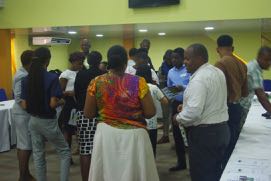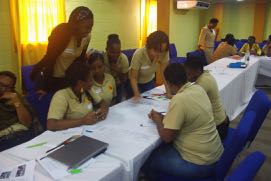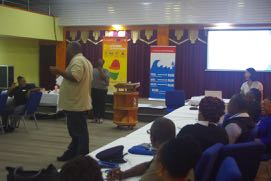The February 2019 to February 2020 Climate Change Mitigation and Adaptation and Disaster Risk Reduction Curriculum (CCMA/DRR) consultancy undertaken by a Sustainability Frontiers team for the Government of St. Vincent and the Grenadines has been successfully concluded. The aim of this World Bank-funded consultancy was to develop a national climate change and disaster risk curriculum for lower secondary school level, attached to which was the development of interlinked environmental education curriculum materials covering issues such as biodiversity loss, marine, coastal and inland ecosystem threats. The SF team was composed of David Selby, Fumiyo Kagawa and a SF Associate member from SF’s partner organization, the Centre for Human Rights and Citizenship Education, Dublin City University, Rowan Oberman.
SVG is at risk from multiple hazards including hurricanes, storms and storm surges, tsunamis, coastal erosion, flooding, drought, landslides, earthquakes and volcanic eruptions. Climate change is exacerbating the severity and frequency of such hazards. The Government of SVG is responding to the increased threat through a regional project funded by the World Bank and the Climate Investment Fund Pilot Program for Climate Resilience. Within the project a key area for investment is the education of children and youth in how to engage with disaster risk reduction (DRR) and the need for climate change mitigation and adaptation (CCMA). The SF consultancy is the flagship development for the SVG education sector.
The stages of the consultancy included: writing an Inception Report (April 2019); team data collection field visits (March and May 2019); researching and writing a review of the SVG national curriculum to locate windows of opportunity for the integration of CCMA/DRR themes and topics (April/May 2019); making an annotated collection of CCMA/DRR learning materials and writing SVG-specific case studies (May 2019); writing the curriculum and associated resources (June to September 2019); writing a resource manual, a learning facilitation guide and a post-trauma teaching and learning guide for teachers (first drafts October 2019; final drafts January 2020); piloting the curriculum and writing a report (November 2019); developing and conducting pre-service, in-service and training the trainer workshops (December to January 2020).
The CCMA/DRR curriculum comprises a modular curriculum for each of secondary grades 1, 2 and 3, the same ten strands framing each module. Those strands are: hazards and disasters, climate change, climatological hazards, geological hazards, human-made hazards and epidemics, planning for disasters, the marine environment, the land environment, ecosystem and biodiversity threats, and water and solid waste.In its interlinking of climate change, disaster risk and other environmental issues, the curriculum aligns with latest thinking on what is called Eco-system-based Disaster Risk Reduction; it also very much anticipates the upcoming UN Decade on Ecosystem Restoration (2021-2030). The CCMA/DRR curriculum is cross-curricular, identifying existing subject and syllabus content with which the units can be dovetailed. It also emphasises the importance of bridging the intersecting learning zones of classroom, school and community. There are 91 learning units in all. Outputs of the consultancy that are to be made available by the government of SVG include: the three curriculum modules (secondary form 1, 2 and 3); a Working Towards a Resilient Future resource manual for teachers and teacher educators, a Working Towards a Resilient Future learning facilitation guide for teachers; a Helping Students Recover from Disaster post-trauma teaching and learning guide; pre-service, in-service and training the trainer training workshop guides.
During their January 2020 visit to SVG, David Selby and Fumiyo Kagawa conducted a day training workshops 28 in-post teachers from 24 of the 27 SVG secondary schools, meaning advocates are present in nearly all schools. They also conducted a one-day training of 31 students from the secondary training program of the SVG Community College Division of Teacher Education. Finally, they facilitated a training the trainer workshop for staff of the Community College Division of Teacher Education, representatives of Ministry of Education departments and of other governmental sectors. The aim of the training was to build a critical mass of familiarity and advocacy for the launch of the new curriculum and to have trainers in place who are ready and able to train successive waves of teachers and thus ensure sustainability of attention to CCMA/DRR across the school system.
- Paricipants join in a Hazard People Search activity
- A group ranks a set of cards on the causes of climate change
- A participat practice advocay for CCMA/DRRcurriculum as others in the workshop role play the skeptical subhect teacher




